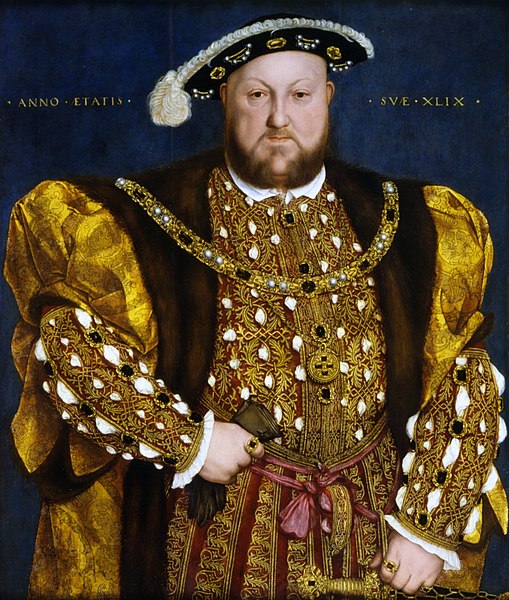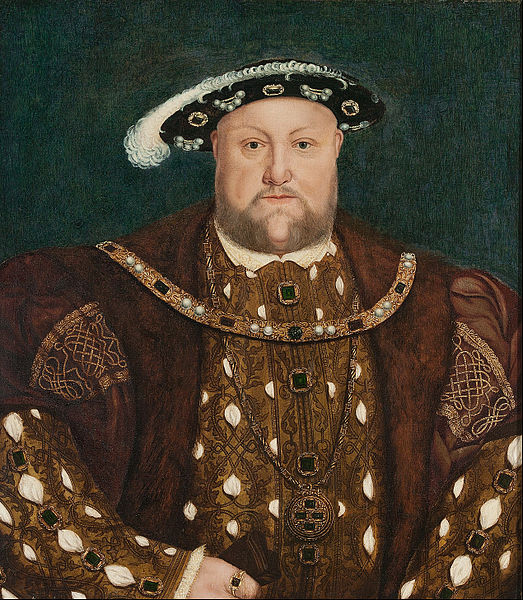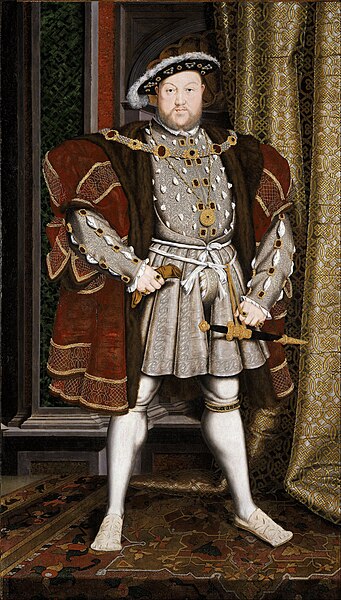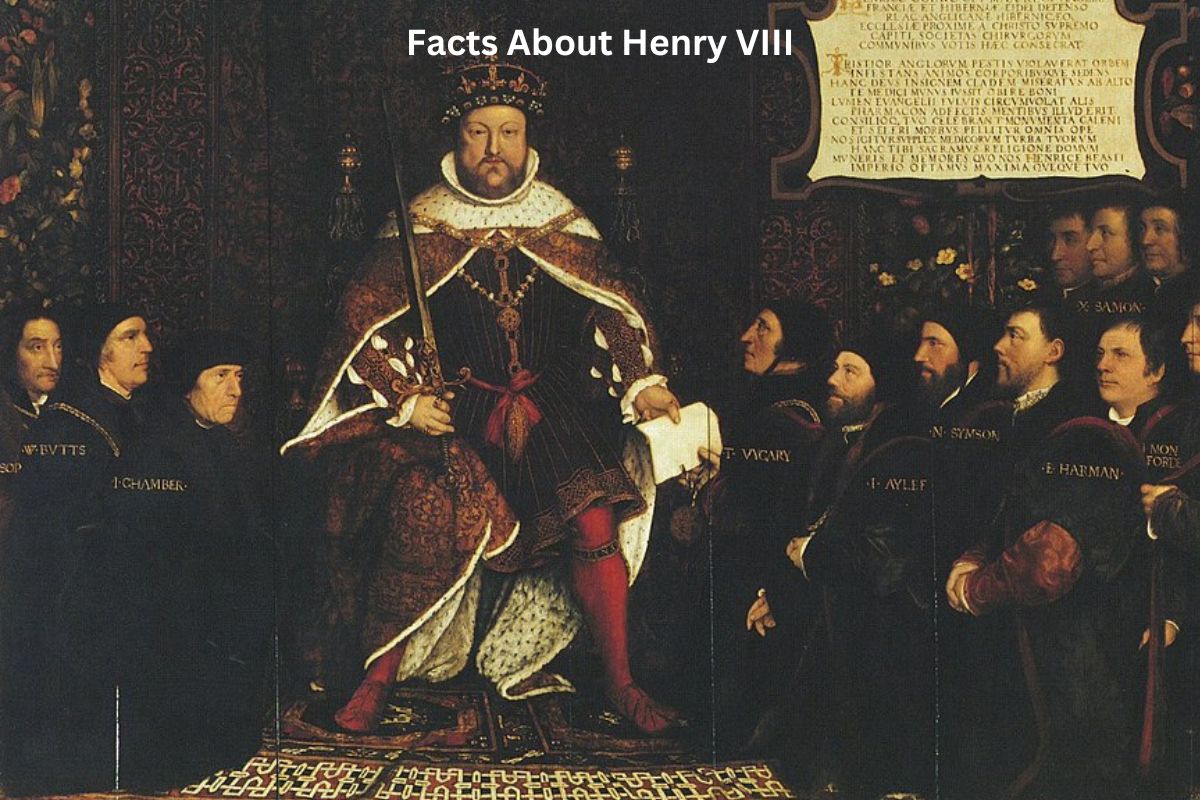Henry VIII (1491-1547) was the King of England from 1509 to 1547, known for his six marriages, which led to the English Reformation and the establishment of the Church of England.
His reign saw military campaigns, cultural patronage, and significant religious changes, marked by the dissolution of monasteries.
He had three legitimate children who became monarchs: Edward VI, Mary I, and Elizabeth I.
Henry’s reign was characterized by political intrigue and marital turmoil. He died in 1547, leaving a lasting impact on English history.
Henry VIII Facts
1. Born in 1491 in London, England
Henry VIII was born on June 28, 1491, at Greenwich Palace in London, England. He was the second son of King Henry VII and Elizabeth of York.
Also Read: Henry the 8ths Wives in Order
His birth was significant because it placed him in line for the throne of England, although he wasn’t initially expected to become king.

2. Became King of England in 1509
Henry ascended to the throne of England in 1509 at the age of 17 following the death of his father, King Henry VII. His coronation took place at Westminster Abbey.
Also Read: Timeline of Henry VIII
This marked the beginning of his reign, which would last for nearly 38 years and become one of the most pivotal periods in English history.
3. He had six marriages
- Henry VIII is perhaps most famous for his six marriages, which had significant political and religious implications:
- Catherine of Aragon (m. 1509-1533): Henry’s first wife, Catherine of Aragon, was the daughter of the King Ferdinand II of Aragon and Queen Isabella I of Castile. Their marriage ultimately ended in annulment, leading to Henry’s split from the Catholic Church.
- Anne Boleyn (m. 1533-1536): Anne Boleyn was Henry’s second wife and the mother of Queen Elizabeth I. Her marriage to Henry led to the English Reformation.
- Jane Seymour (m. 1536-1537): Jane Seymour was Henry’s third wife and the one who provided him with a male heir, Edward VI. Sadly, she died shortly after childbirth.
- Anne of Cleves (m. 1540-1540): Henry’s fourth wife, Anne of Cleves, was a political marriage arranged to strengthen alliances but was quickly annulled due to Henry’s dissatisfaction with her appearance.
- Catherine Howard (m. 1540-1542): Catherine Howard, Henry’s fifth wife, was executed for alleged adultery and treason.
- Catherine Parr (m. 1543-1547): Catherine Parr was Henry’s sixth and final wife. She outlived him and played a role in the upbringing and education of Henry’s children.
Henry’s quest for a male heir and his tumultuous marriages played a central role in shaping the course of English history, as it led to the English Reformation and the establishment of the Church of England.
4. Led the English Reformation
Henry VIII’s desire to annul his first marriage to Catherine of Aragon and marry Anne Boleyn set in motion the English Reformation. The Pope’s refusal to grant the annulment prompted Henry to take matters into his own hands.
In 1534, he passed the Act of Supremacy, which declared the King of England as the supreme head of the Church of England, effectively breaking from the authority of the Pope in Rome.
This marked a significant religious and political shift in England and laid the foundation for Protestantism to take root in the country.

5. Established the Church of England
As a result of the English Reformation, Henry VIII established the Church of England, also known as the Anglican Church. The Church of England retained some Catholic traditions and practices but rejected papal authority.
This new religious institution became the official state church of England, with Henry as its head. It played a central role in shaping the religious landscape of England and would later influence the religious history of other countries.
6. Dissolved monasteries and convents
As part of his efforts to consolidate power and accumulate wealth, Henry VIII initiated the dissolution of monasteries and convents in England. Between 1536 and 1541, he ordered the closure and confiscation of their properties, including vast estates and valuable assets.
This campaign, known as the Dissolution of the Monasteries, had significant economic and social consequences, redistributing land and wealth to the crown and nobility and altering the religious landscape of England.
7. Passed the Act of Supremacy in 1534
In 1534, Henry VIII enacted the Act of Supremacy, a pivotal piece of legislation that declared the King as the supreme head of the Church of England, independent of the authority of the Pope.
This act marked the official break from the Roman Catholic Church and established the monarch’s authority over religious matters within England. Those who refused to recognize the King’s supremacy faced severe consequences, including imprisonment and execution.
The Act of Supremacy was a cornerstone of the English Reformation and solidified the separation of the Church of England from the Catholic Church.
8. Executed Anne Boleyn in 1536
Anne Boleyn, Henry’s second wife, played a significant role in the English Reformation. However, her marriage to Henry ended tragically. She was accused of adultery, incest, and high treason, charges many historians believe were politically motivated.
Anne was arrested, tried, and ultimately executed by beheading in May 1536. Her execution had a profound impact on Henry personally and politically, as well as on the religious landscape of England.

9. Had a son, Edward VI, with Jane Seymour
Jane Seymour, Henry’s third wife, is often regarded as his favorite wife. She gave birth to his long-awaited male heir, Edward VI, in October 1537. This was a momentous occasion for Henry, as securing the succession with a male heir was one of his primary concerns.
Unfortunately, Jane Seymour died just days after giving birth, which plunged Henry into mourning.
10. Suffered from various health problems
In his later years, Henry VIII suffered from various health problems, some of which can be attributed to his lifestyle and diet. He became severely overweight, leading to obesity-related health issues.
Additionally, he developed painful leg ulcers, which may have been caused by various factors, including poor circulation and his jousting injuries. These health issues likely contributed to his notorious temper and may have impacted his decision-making.
11. Patron of the arts
Despite his tumultuous reign and personal life, Henry VIII was known for his interest in the arts and culture. He supported the flourishing of the Renaissance in England and was a patron of artists, musicians, and writers.
Notably, he composed music and played several instruments, including the lute and harp. His court was a center of cultural activity during his reign.
12. Led assertive foreign policies
Henry pursued an assertive foreign policy during his reign, seeking to establish England as a prominent European power. He engaged in several military campaigns, including wars with France and Scotland.
The most notable conflict was the Battle of Flodden in 1513, where the English defeated the Scots. Henry’s reign marked a period when England became more assertive on the international stage and sought to expand its influence and territory.
13. Died in 1547, succeeded by Edward VI
Henry VIII died on January 28, 1547, at the age of 55. He was succeeded by his young son, Edward VI, who was only nine years old at the time. Edward’s reign was short but marked by significant religious reforms.
Henry’s death eventually led to the complex and often tumultuous reigns of his three children: Edward VI, Mary I, and Elizabeth I, each of whom left their own indelible marks on English history.
